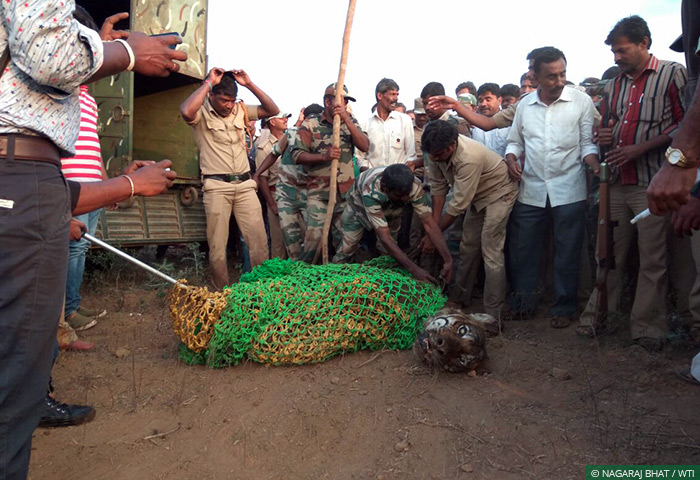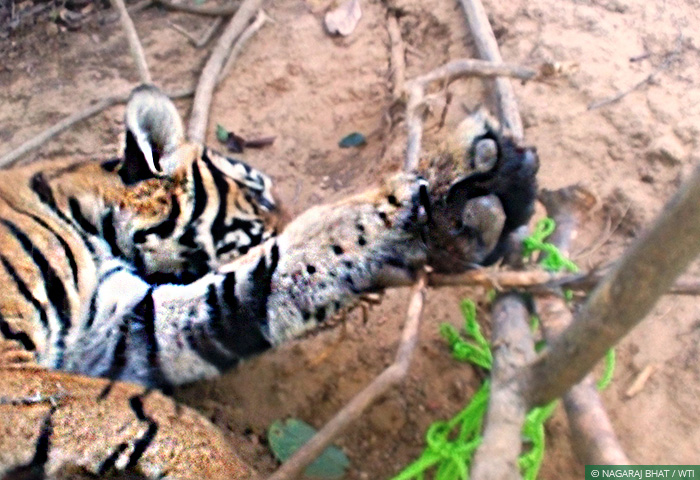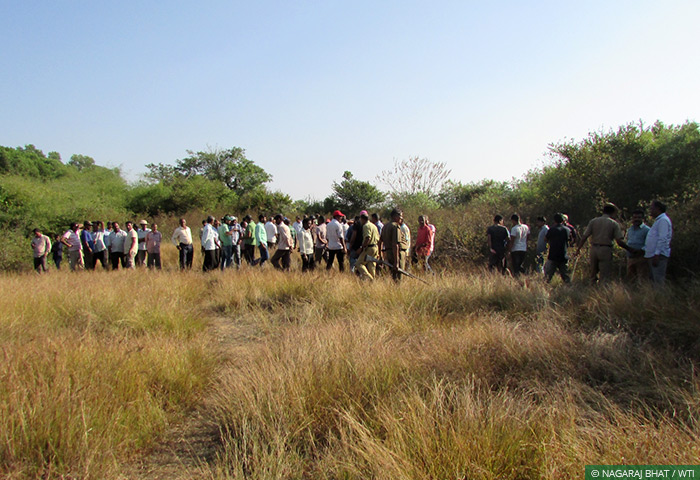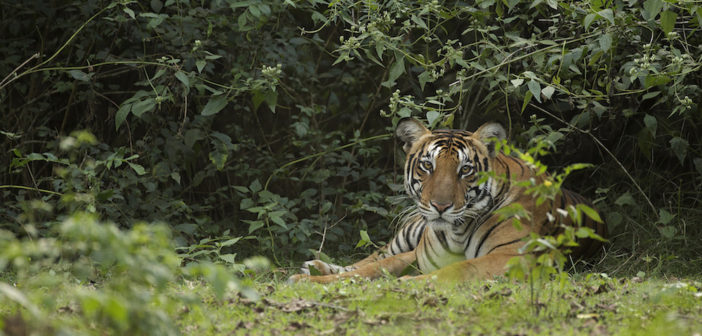By Sudheer KS & Nagaraj Bhat
Karnataka has the highest tiger population in India. An increased awareness of the importance of wildlife conservation, state policies guided by Project Tiger, and effective ground level protection have combined to allow tiger numbers in the state to rebound and steadily rise. The old Mysore landscape in particular – about 10,000 square kilometers of connected forest across the Kodagu, Mysore and Chamarajnagar districts – is prime tiger habitat, exquisitely suitable for the long-term survival of this magnificent animal.
But big cats need large areas to roam, and the degradation and fragmentation of wild landscapes beyond our protected forests has meant that tigers are facing something of a space crunch. The increase in tiger numbers may be reason to cheer, but the corresponding increase in the density of tigers inside Protected Areas has become a cause of concern, especially for people living on the fringes of forests. The year 2016 bore witness to this fact: there were nearly 20 incidents in the old Mysore landscape involving tigers coming into conflict with humans.

Massive, jostling, angry crowds are the hallmark of a typical tiger rescue
Ugly and ill-spirited
Most tiger conflict incidents devolve into a display of how ugly we humans can become; a vivid exhibition of the hatred and contempt we harbour towards our wild cohabitants. The sighting of a tiger around a village gives rise to ‘tiger fever’, an epidemic that spreads faster than wild fire by means of missed calls on mobile phones. Thousands gather in a blink, well before the professionals from the forest department can arrive at the scene.
Before the veterinarian, trying to gauge the quantity of sedative that should be administered, can even take a look inside the lantana thicket where the tiger has sought refuge, some local political leader will have called a dozen times, haranguing the forest department to ensure that no human being is hurt… or else. The vet will also have to cope with a cacophony of ill-spirited ‘volunteers’. Drunk on rum or whisky, they will all try to corner the panic-stricken beast as if they are ready to pull it by the tail, making it impossible for the vet to line up the animal in the sights of his tranquiliser gun.
If against all odds, the vet does finally succeed in sedating the animal, the thousands of people gathered around it will begin to shout – not in joy, but as if they were an audience at the Roman colosseum – “Kill… kill… kill!” Some will have gallons of kerosene or diesel at the ready, happy to burn the animal alive. The growling mob will browbeat the forest department and conservationist groups eager to save the tiger, and convict them on the spot for the offense of having introduced the tiger to their village.
It takes the patience of a Buddha, the wit of a Chanakya, and finally the cane of the police to successfully whisk the sedated animal from the scene to a safe refuge. There its future can finally be determined: whether it will spend the rest of its years as a showpiece in a zoo, or can be reintroduced to another part of the forest. Or, if it has been fatally injured, it will spend its final hours at the rescue centre, waiting for the end to come.
This has been the story of almost every Human-Tiger Conflict situation in which we have participated. Our experiences indicate an uncertain future for our national animal. How is it that the country spends billions of rupees to protect the tiger, only for it to be hated and rejected by its people? All sorts of questions arise.

The tiger we rescued from the Coorgi village was caught in a wire snare in the middle of a privately owned agricultural plot
A Flicker of Hope
But all, it seems, is not lost. Not yet. On January 18, we received intimation from the forest department that another alarm had been sounded. Another tiger had strayed into human habitation, this time into a village near Nagarhole Tiger Reserve.
As usual, rigorous preparations were made with an eye to handling the possible eventualities of a conflict situation. With the caution of a soldier entering an enemy bunker, the rescue team arrived at the spot. But what we witnessed was a pleasant surprise.
No one had ventured near the animal, who was trapped in a wire snare in the middle of a privately-owned agricultural field. There were no ‘missed call’ veterans reaching out to others of their ilk, no ill-spirited volunteers cornering the animal, and no political pressure, not the even slightest interference from the village headman.
The local villagers all waited at a respectful distance, whispering among themselves, listening for the tell-tale sound of the tranquiliser gun. Gradually, after the sedated animal had been shifted into the transport cage, a few dozen approached the forest officers with a quiet request to peek at the tiger. Granted permission, they did this swiftly and by turn, returning to their vantage point at a distance afterwards. Later, they helped to lift the cage into the truck that was waiting to transport the animal to the rescue centre.
Of all the capture and rescue situations we have witnessed recently, this one has made the strongest impression. The behaviour that these Coorgis (inhabitants of Coorg/Kodagu) exhibited – their impeccable discipline and manners, presence of mind, sense of ownership to the problem and attitude towards wildlife – was exemplary and unprecedented.
The rescue team could discuss nothing else on the way to the Mysore rescue centre. Some said it was the result of the high rate of literacy and education in this community. Some said it was a cultural attachment and sense of belonging towards the forest. Others believed it was the Coorgis’ army discipline. Ultimately, though, we concluded it was something more essential: showing respect and empathy towards an injured wild animal was just a matter of being human, in the true sense of that word, towards wildlife.

The Coorgi villagers standing at a distance during the recent rescue
Sudheer KS is an advocate who assists the Wildlife Trust of India (WTI). Nagaraj Bhat is a Field Officer with WTI.
Originally published on Wildlife Trust of India’s website.
Featured image: tiger in Nagarhole Tiger Reserve, credit Rohit Varma, CC BY 2.0 / cropped. All other images courtesy Wildlife Trust of India.





